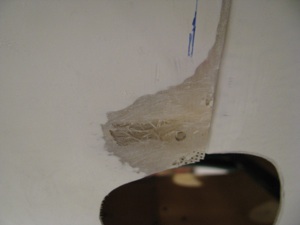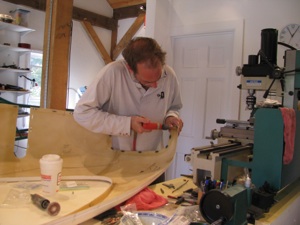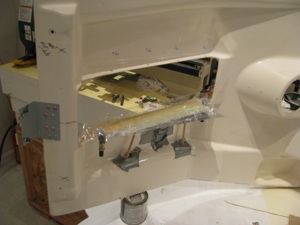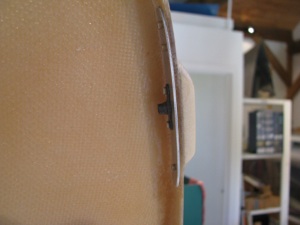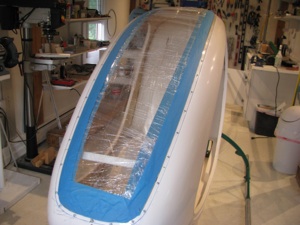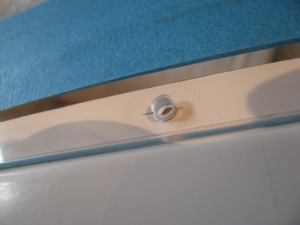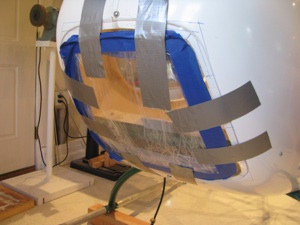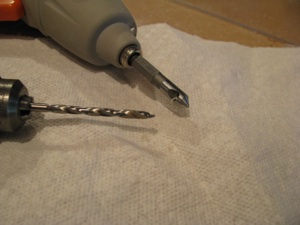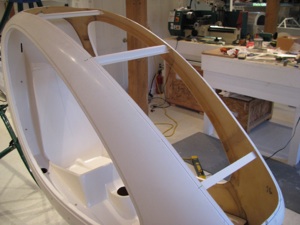Windscreen
Chin Window Drilling & Cabin Fiberglass
10/11/11 22:50 Filed in: All
Cleaning up a lot of little things. Here is a spot on the body that was bubbled and mostly gelcoat. Ground it out, heat and flattened the fiberglass with a heatgun and pressed it between some angle to straighten . Finally layed up a couple of thin layers to add strength and bondoed to smooth it out.
There were a couple of spots that required this treatment.
Here is where the pre-drilled holes didn’t quite line up with where the floorpan actually fell. Had to drill a new one and fill the old.
FAA required picture of me working. Gotta remember to get more of these. Since I am usually working alone it means getting out the tripod and setting up the camera timer. Coffee fueled build process.
Holes are easy to drill, but each one needs a nutplate and there sure are a lot of them. Here I am drilling and mounting the chin window floating nutplates.
There’s a lot more fiberglass work than I anticipated. This is the lip of the floorpan along the base of the instrument pod. The drilled holes cut through the edge of the lip.
I had to first cut away the fiberglass with the partial holes. A dam was built with packing tape and a tape covered aluminum sheet. Then an thin layer of flox to allow the edge to form, then five layers of cloth. I’ll have to sand a lot of it down, but it should allow for a tight fit with plenty of meat around the holes. It’ll be a lot “taller” than the original lip.
In a few places I had to shim the pan, especially up around the curve of the top of the body. A layer of foam sanded to the correct thickness, then glassed over. To mount the nutplates behind the lip I had to cut a strip of aluminum, mount the nutplate, then rivet it outside the foamed area.
Drilling Windscreen & Bodywork
08/11/11 22:46 Filed in: All
It’s been a few weeks with slow progress. I fitted and trimmed the windscreen and lower plexi and drilled them to the frame.
The windscreen and lower window really add a lot of strength to the cabin. It’s pretty solid now. My shop was about 90 degrees, so the plexi was pretty flexible and the holes drilled cleanly. Only a few will need some sanding and beveling as there looks to be a chip or two on the backside.
Most of the holes look like this after drilling and beveling. Overall I am pleased with the result
Initial Screen Fitting
07/22/11 22:39 Filed in: All
Lower plexi taped in place on front. Lot’s of trimming to fit the joggle cleanly. It has been drilled and I purchased a bunch of #6 floating nutplates after having read the experiences of others. Apparently with the instrument cluster in place there is almost no way to get your hands in there to place acorn nuts.
Here is my dynamic duo for drilling the plexi. The drill bit is a #27 plexi bit from Avery Tool. It has a shallow cutting 60 degree point. The countersink I picked up from the sale bin at Harbor Freight. It has a single flute and just barely shaves, which leaves a nice, chatter-free chamfer on the plexi holes. $3.99 for a set of three. It would probably dull immediately on aluminum or steel, but it’s great for this application.
The windscreen opening is pretty floppy without the windscreen. I hot glued some foamcore “I-beams” to hold the width to almost exactly match the windscreen. Makes fitting and holding the windscreen in place much easier. I thought peeling the hotglue out would be easy when I’m done, but I tried peeling off a blob and it really, really grips that rough fiberglass pretty securely in fact. Oh well.

